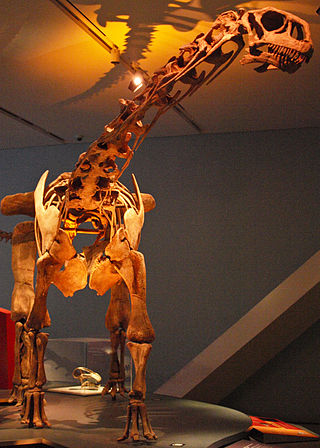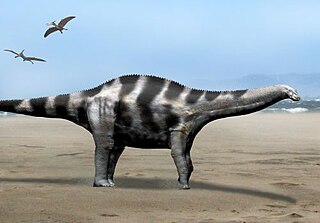
Sauroposeidon is a genus of sauropod dinosaur known from several incomplete specimens including a bone bed and fossilized trackways that have been found in the U.S. states of Oklahoma, Wyoming, and Texas.

Neovenator is a genus of carcharodontosaurian theropod dinosaur. It is known from several skeletons found in the Early Cretaceous Wessex Formation on the south coast of the Isle of Wight, southern England. It is one of the best known theropod dinosaurs from the Early Cretaceous of Europe.
Amazonsaurus is a genus of diplodocoid sauropod dinosaur from the Early Cretaceous Period of what is now South America. It would have been a large-bodied quadrupedal herbivore with a long neck and whiplash tail. Although more derived diplodocoids were some of the longest animals ever to exist, Amazonsaurus was probably not more than 12 meters (40 ft) long. Gregory S. Paul estimated in 2010 its weight at 5000 kg.

Amargasaurus is a genus of sauropod dinosaur from the Early Cretaceous epoch of what is now Argentina. The only known skeleton was discovered in 1984 and is virtually complete, including a fragmentary skull, making Amargasaurus one of the best-known sauropods of its epoch. Amargasaurus was first described in 1991 and contains a single known species, Amargasaurus cazaui. It was a large animal, but small for a sauropod, reaching 9 to 13 meters in length. Most distinctively, it sported two parallel rows of tall spines down its neck and back, taller than in any other known sauropod. In life, these spines could have stuck out of the body as solitary structures that supported a keratinous sheath. An alternate hypothesis, now more favored, postulates that they could have formed a scaffold supporting a skin sail. They might have been used for display, combat, or defense.
Ligabueino is a genus of noasaurid dinosaur named after its discoverer, Italian doctor Giancarlo Ligabue. It is known only from an extremely fragmentary specimen, measuring 79 cm (2.6 ft) long, found in the La Amarga Formation. In spite of initial reports that it was an adult, the unfused vertebrae indicate that the specimen was a juvenile. It was a theropod and lived during the Early Cretaceous Period, in what is now Patagonia. Contrary to initial classifications that placed it as a member of the Noasauridae, Carrano and colleagues found in 2011 that it could only be placed with any confidence in the group Abelisauroidea.

Malawisaurus is an extinct genus of titanosaurian sauropod dinosaur. It is known from the Dinosaur Beds of northern Malawi, which probably date to the Aptian stage of the Early Cretaceous. The type species is M. dixeyi and the specific name honours Frederick Augustus Dixey.

Moabosaurus is a genus of turiasaurian sauropod dinosaur from the Early Cretaceous Cedar Mountain Formation of Utah, United States.
Galve is a municipality located in the province of Teruel, Aragon, Spain. According to the 2006 census (INE), the municipality has a population of 145 inhabitants. There is an important paleontological site.

The Urbión Group is a geological group in Castile and León and La Rioja, Spain whose strata date back to the Early Cretaceous (late Hauterivian to late Barremian. The formations of the group comprise a sequence of brown limestones in a matrix of black silt, sandstones, claystones and conglomerates deposited under terrestrial conditions, in alluvial fan and fluvial environments.

Demandasaurus is a genus of rebbachisaurid sauropod dinosaur from early Cretaceous deposits of Spain. Demandasaurus is known from an incomplete but associated skeleton that includes cranial and postcranial remains. It was collected from the Castrillo de la Reina Formation in Burgos Province of Spain. It was first named by Fidel Torcida Fernández-Baldor, José Ignacio Canudo, Pedro Huerta, Diego Montero, Xabier Pereda Suberbiola and Leonardo Salgado in 2011 and the type species is Demandasaurus darwini.
Telmasaurus is an extinct genus of varanoid lizard from the Late Cretaceous of Mongolia. Fossils have been found from the Djadokha and Barun Goyot Formations that date between the early and middle Campanian stage from approximately 80 to 75 million years ago. The type species Telmasaurus grangeri was named in 1943.

Mesoraphidiidae is an extinct family of snakeflies in the suborder Raphidiomorpha. The family lived from the Late Jurassic through the Late Cretaceous and is known from twenty-five genera. Mesoraphidiids have been found as both compression fossils and as inclusions in amber. The family was first proposed in 1925 by the Russian paleoentomologist Andrey Vasilyevich Martynov based on Upper Jurassic fossils recovered in Kazakhstan. The family was expanded in 2002 by the synonymizing of several other proposed snakefly families. The family was divided into three subfamilies and one tribe in a 2011 paper, further clarifying the relationships of the included genera.

Camarillasaurus is a genus of spinosaurid dinosaur from the Early Cretaceous period (Barremian) of Camarillas, Teruel Province, in what is now northeastern Spain. Described in 2014, it was originally identified as a ceratosaurian theropod, before being referred to the Spinosauridae in 2021.
Horshamosaurus is a genus of herbivorous ankylosaurian dinosaur from the Early Cretaceous of England. It lived during the Barremian of the Cretaceous and the type species is Horshamosaurus rudgwickensis.
Tengrisaurus is a genus of lithostrotian sauropod, from the Early Cretaceous (Barremian-Aptian) Murtoi Formation, Russia. It was described in 2017 by Averianov & Skutschas. The type species is T. starkovi. New remains were described in 2021 by Averianov, Sizov & Skutschas.

Leyvachelys is an extinct genus of turtles in the family Sandownidae from the Early Cretaceous of the present-day Altiplano Cundiboyacense, Eastern Ranges, Colombian Andes. The genus is known only from its type species, Leyvachelys cipadi, described in 2015 by Colombian paleontologist Edwin Cadena. Fossils of Leyvachelys have been found in the fossiliferous Paja Formation, close to Villa de Leyva, Boyacá, after which the genus is named. The holotype specimen is the oldest and most complete sandownid turtle found to date.

Sibirotitan is a genus of somphospondyl sauropod from the Ilek Formation of Russia. The type and only species is S. astrosacralis.

Sachicasaurus is an extinct genus of brachauchenine pliosaurid known from the Barremian of the Paja Formation, Altiplano Cundiboyacense in the Colombian Eastern Ranges of the Andes. The type species is S. vitae.

Vallibonavenatrix is a genus of spinosaurid dinosaur from the Early Cretaceous (Barremian) Arcillas de Morella Formation of Castellón, Spain. The type and only species is Vallibonavenatrix cani, known from a partial skeleton.
The Castrillo de la Reina Formation is a geological formation in Spain. It is late Barremian to early Aptian in age. It interpreted as a fluvial deposit. It primarily consists of red clay, with ribbon shaped sandstone channel fills. The rebbachisaurid dinosaur Demandasaurus occurs in the formation, alongside somphospondylan Europatitan as well as indeterminate small ornithopods, iguanodonts and spinosaurids, the earliest known stem-rhabdodontid (indeterminate) and the lizard Arcanosaurus.












